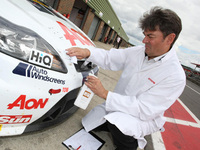Bug splats wreak havoc with car paintwork

Extensive research carried out by the UK’s leading car care expert, Autoglym, has revealed that insect remains are equally as damaging to car paintwork as bird lime. Findings show that similar levels of acidity can be found in both deposits, which, if left untreated and in direct sunlight, can lead to the deterioration of lacquer on paintwork.
As part of their continuous product testing regime, Autoglym’s laboratory technicians called upon 25 year-old British Touring Car Championship (BTCC) contender, Tom Chilton, and his Team AON Ford Focus at Snetterton race circuit in Norfolk.
Following several high-speed laps, Autoglym evaluated its Active Insect Remover on baked-on insects, which had hit the front of the 270bhp LPG-powered BTCC Ford Focus at an impact speed of up to 144.5mph, more than twice the UK’s maximum legal speed limit. Despite the extreme conditions, the purpose-designed formulation proved highly effective in removing the remnants of insects which had bonded with the leading edge of the Focus’ bonnet.
Paul Caller, Autoglym’s CEO, said: “It’s important in these summer months, when the flying insects of various types are most prevalent, that motorists are vigilant in removing bug splats as soon as possible. Acidic deposits – bug splats and bird lime – can begin to degrade lacquer after just 10 minutes.
“We’d urge motorists to use one of the pH-neutral products on the market, such as Autoglym’s Active Insect Remover, which when used as soon as possible on insect remains, should prevent damage to paint finishes. Additional treatments, such as a premium wax, will serve as further protection against acidic deposits of future bug splats.”
More information about Autoglym’s range of premium car-care products, and details of nearby retailers, is available at Autoglym.com.




